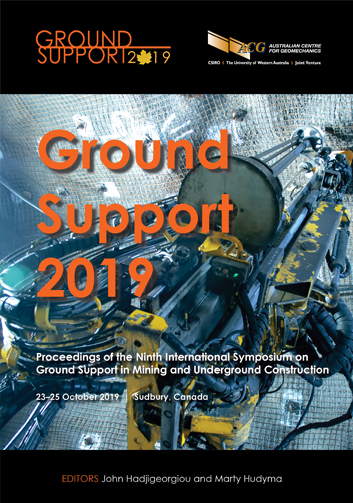Dynamic testing: determining the residual dynamic capacity of an axially strained tendon

|
Authors: Knox, G; Berghorst, A |
DOI https://doi.org/10.36487/ACG_rep/1925_14_Knox
Cite As:
Knox, G & Berghorst, A 2019, 'Dynamic testing: determining the residual dynamic capacity of an axially strained tendon', in J Hadjigeorgiou & M Hudyma (eds), Ground Support 2019: Proceedings of the Ninth International Symposium on Ground Support in Mining and Underground Construction, Australian Centre for Geomechanics, Perth, pp. 231-242, https://doi.org/10.36487/ACG_rep/1925_14_Knox
Abstract:
The specification of a tendon is stated as the capacity of the tendon in pristine condition on the day of delivery to the mine. A number of factors result in the degradation of the capacity of a tendon. Factors such as, but not limited to, installation quality, corrosion, and ground movement are all understood to reduce the residual capacity of a system. An understanding of the effects of the degradation of a tendon is important when determining the risk of an excavation. Rock support tendons are discretely tested quasi-statically (closure) or dynamically (seismicity) depending on the conditions expected with the mine environment. Although this testing is valuable, it is likely that a tendon subjected to rapid ground movement (seismicity) would first be subjected to some level of slow closure. This paper forms a basis for future work into determining the residual capacity of a tendon; the focus of this paper is to determine the residual dynamic capacity of an axially elongated tendon. Samples were axially elongated quasi-statically and fixed into place prior to being subjected to a single dynamic impulse (56 kJ), resulting in the rupture of the tendon, using the Dynamic Impact Tester from New Concept Mining. A trend of increasing ultimate dynamic load and total elongation (determined as the summation of the quasi-static and dynamic displacement) sustained prior to the rupturing of the tendon, was noted. However, the total energy absorbed by the tendon indicated the fact that the total energy of the tendon remained constant.
Keywords: dynamic testing, ground support, pre-elongated, squeezing ground, seismic event, rockbolt, PAR1 Resin Bolt, Dynamic Impact Tester, New Concept Mining
References:
ASTM International 2008, Standard Test Methods for Laboratory Determination of Rock Anchor Capacities by Pull and Drop Tests (ASTM D7401-08), ASTM International, West Conshohocken.
Bosman, K, Cawood, M & Berghorst, A 2018, ‘The relationship between the magnitude of input energy per impulse and total absorbed energy’, Proceedings of the 3rd International Conference on Rock Dynamics and Applications (RocDyn-3), CRC Press/A.A. Balkema.
Delport, M & Knox, G 2018, Dynamic Performance of a 20 mm, 2.4 m PAR1 Resin Bolt when subjected to a 56 kJ impulse at 5.9 m/s, New Concept Mining, Johannesberg.
Hadjigeorgiou, J 2016, ‘Rock support: degradation and failure’, Proceedings of the 8th International Symposium on Ground Support in Mining and Underground Construction, Luleå University of Technology, Luleå, pp. 1–22.
Knox, G & Berghorst, A 2018, ‘Increased agility for the research and development of dynamic roof support products’, Proceedings of the 3rd International Conference on Rock Dynamics and Applications (RocDyn-3), CRC Press/A.A. Balkema.
Knox, G, Crompton, B & Berghorts, A 2018, ‘The relationship between the magnitude of impact velocity per impulse and cumulative absorbed energy capacity of a rock bolt’, Proceedings of The Fourth Australasian Ground Control in Mining Conference Proceedings, The Australasian Institute of Mining and Metallurgy, Melbourne, pp. 160–169.
Li, CC 2017, Rockbolting: Principles and Applications, Butterworth-Heinemann, Oxford.
Stacey, TR 2012 ‘Support of excavations subjected to dynamic (rockburst) loading’, Proceedings of the 12th International Congress of the International Society of Rock Mechanics, Taylor & Francis Group, London, pp. 137–145.
© Copyright 2025, Australian Centre for Geomechanics (ACG), The University of Western Australia. All rights reserved.
View copyright/legal information
Please direct any queries or error reports to repository-acg@uwa.edu.au
View copyright/legal information
Please direct any queries or error reports to repository-acg@uwa.edu.au